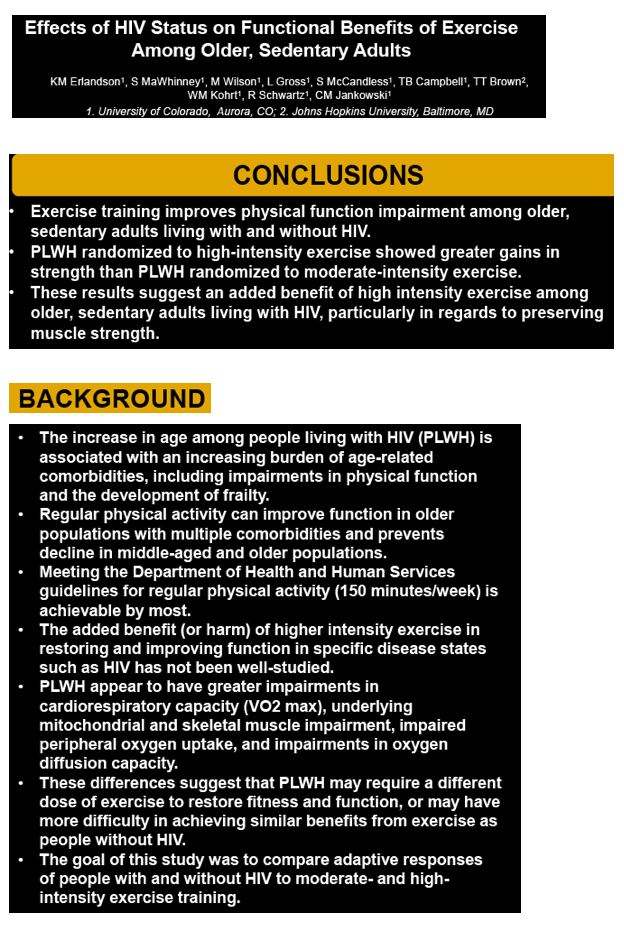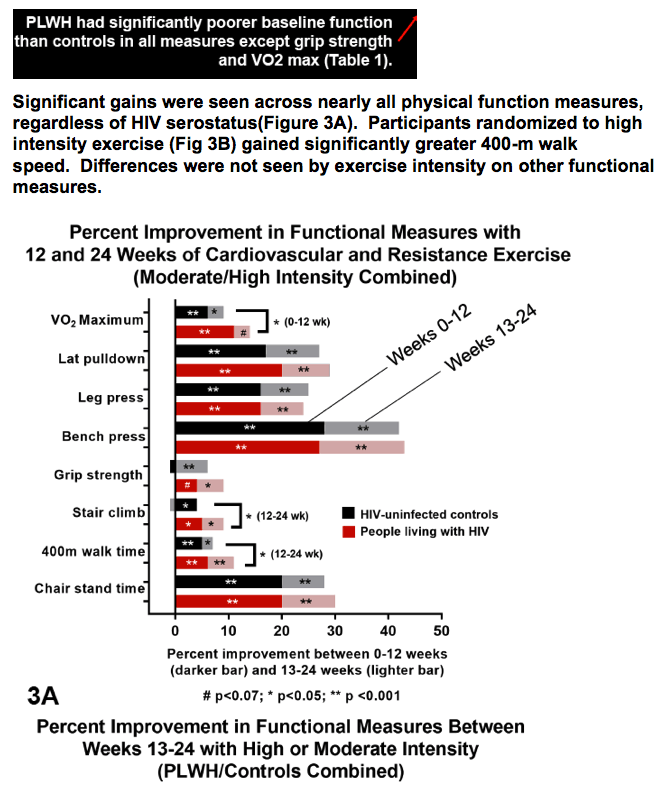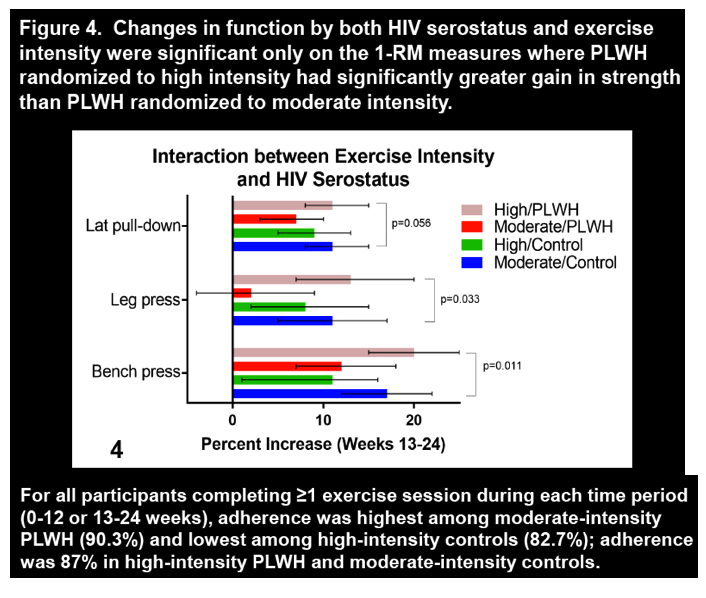 |
 |
 |
| |
High-Intensity Exercise Has Edge Over Moderate Intensity in Older Group With HIV
|
| |
| |
25th Conference on Retroviruses and Opportunistic Infections (CROI), March 4-7, 2018, Boston
from Jules: we have NOT been conducting good exercise studies because NIH & NIAID & HHS & OAR leadership has NOT adequately addressed the needs for aging HIV+, it has been essentially ignored & under funded. researchers are unable to get funding support for HIV aging studies because leadership has de-prioritized this problem. They may have it listed smog their priorities but it does NOT get the attention it needs & deserve, thus is a betrayal of older aging HIV+ by leadership leaving these older aging HIV+ to increased potential mortality rates without trying to do more including better services for aging & their clinics & better and more aging research. NYC is the only city that has started a process to develop a network of services for older aging HIV+. . NYC is the only city that has started a process to develop a network of services for older aging HIV+. I have been working with NYC DOH leadership to develop services. I would be glad to speak with anyone who is interested in beginning such a process in their city, because don't hold your breath waiting for the federal leaders to do anything.
Mark Mascolini
Exercise improved physical function in older sedentary HIV-positive and negative adults, according to results of a 24-week 69-person randomized study [1]. Among people with HIV infection, those randomized to high-intensity exercise gained more strength than counterparts randomized to moderate-intensity exercise.
Researchers at the University of Colorado, Aurora, and Johns Hopkins University noted that aging people with HIV, especially sedentary people, risk frailty and impairments in physical function that can adversely affect health. They maintained that most older people with HIV can meet US Department of Health and Human Services guidelines calling for 150 minutes of physical activity weekly. But the added benefits--or risks--of high-intensity exercise remain poorly understood in people with HIV.
Compared with the general population, people with HIV have greater physiological impairments, such as impaired cardiorespiratory capacity (VO2max), mitochondrial and skeletal muscle impairment, and impaired oxygen uptake and diffusion capacity. These differences, the researchers proposed, may mean people with HIV need "a different dose of exercise to restore fitness and function." They conducted this study to address these issues.
Researchers enrolled sedentary people with well-controlled HIV infection and uninfected participants 50 to 75 years old. All underwent a 24-week supervised cardiovascular and resistance program with a 3-times-weekly target. Everyone began with 12 weeks of moderate-intensity exercise (50% of VO2max and 60% to 70% 1-repetition maximum). Then researchers randomized participants to continue the moderate-intensity program for 12 weeks or to switch to a high-intensity program (70% VO2max, 80% or more 1-repetition maximum). The researchers measured functional outcomes (such as 10-times chair rise) periodically throughout the 24 weeks. Because age, sex, and body mass index had minimal effects on estimates, they presented unadjusted values.
Sixty-nine participants (32 with HIV) started the exercise program, 60 (28 with HIV) completed week 12, and 56 (27 with HIV) completed the entire program. In the HIV group and the control group, age averaged 56.8 and 58.0, 88% and 95% were men, 63% and 84% were white, and 16% and 11% currently smoked. People with HIV averaged 11.1 years of continuous antiretroviral therapy, and current CD4 count averaged 599. Compared with controls at the initial visit, people with HIV scored worse in chair stand time, 400-meter walk, bench press, and all other fitness measures except grip strength and VO2max.
The research team recorded significant improvements in nearly all physical function measures in both the HIV group and the control group through weeks 12 and 24. In the entire study group, people randomized to high-intensity exercise significantly improved 400-meter walk speed compared with the moderate-intensity group from week 13 to 24. But high-intensity exercise offered no advantage in 7 other functional measures.
HIV-positive people randomized to the high-intensity program gained significantly more strength (measured by lat pulldown, leg press, and bench press) than HIV-positive people who continued moderate-intensity exercise. Among all people with HIV, the proportion with impairment measured on the short physical performance battery or by frailty components dropped after 12 and 24 weeks of exercise.
Among people who completed at least 1 exercise session in weeks 0-12 and 13-24, adherence proved highest in the moderate-intensity HIV group (90.3%) and lowest in high-intensity controls (82.7%). The high-intensity HIV group and moderate-intensity controls both attained 87% adherence.
The Colorado-Hopkins team concluded that a 24-week supervised exercise program improves physical function in sedentary people with and without HIV. In the HIV group, greater strength gains with high-intensity versus moderate-intensity exercise "suggest an added benefit of high-intensity exercise" in older sedentary adults with HIV.
Reference
1. Erlandson KM, MaWhinney S, Wilson MP, et al. Effects of HIV status on functional benefits of exercise in older sedentary adults. 25th Conference on Retroviruses and Opportunistic Infections (CROI). March 4-7, 2018. Boston. Abstract 755.





|
| |
|
 |
 |
|
|